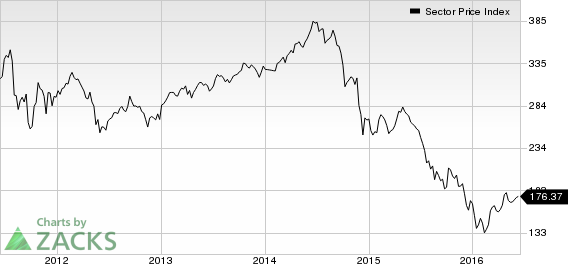The U.S. Energy Department's weekly inventory release showed that crude stockpiles recorded a small. However, supplies at the Cushing, OK storage hub increased. The report further revealed that gasoline inventories fell from its previous week level, while distillate stocks rose unexpectedly.
Brexit & Fed Hike Risks Overshadow Mixed EIA Data
However, oil traders chose to overlook mixed trends from the EIA data set and were more concerned about the uncertainty surrounding U.S. Federal Reserve’s timing and path of rate hike this year. The commodity was also dragged down by the looming possibility of Britain leaving the European Union. As a result, West Texas Intermediate (WTI) crude futures fell 1% (or 48 cents) to settle at $48.01 per barrel Wednesday.
Analysis of the EIA Data
Crude Oil: The federal government’s EIA report revealed that crude inventories decreased by 933,000 barrels for the week ending June 10, 2016, following a decline of 3.23 million barrels in the previous week.
The analysts surveyed by S&P Global Platts – the leading independent commodities and energy data provider – had expected crude stocks to go down some 1.4 million barrels. Lower imports and production led to the modest stockpile drawdown with the world's biggest oil consumer even as refinery usage dipped.
However, crude inventories at the Cushing terminal in Oklahoma – the key delivery hub for U.S. crude futures traded on the New York Mercantile Exchange – were up 904,000 barrels from previous week’s level to 66.46 million barrels.
Despite the fifth inventory decline in 6 weeks, at 531.54 million barrels, current crude supplies are up 14% from the year-ago period and are at the highest level during this time of the year.
The crude supply cover – at 32.6 days – remained flat from the previous week. In the year-ago period, the supply cover was 28.5 days.
Gasoline: Supplies of gasoline were down for the fourth time in 6 weeks as demand strengthened and production fell. The 2.63 million barrels draw – more than double the analysts’ polled number of 1.25 million barrels decrease in supply level – took gasoline stockpiles down to 237 million barrels. Despite last week’s build, the existing stock of the most widely used petroleum product is 9% higher than the year-earlier level and is comfortably above the upper half of the average range.
Distillate: Distillate fuel supplies (including diesel and heating oil) edged up 786,000 barrels last week, as opposed to analysts’ expectations for a 750,000 barrels drop in inventory level. The increase in distillate fuel stocks – the second in as many weeks – could be attributed to rising production. At 152.16 million barrels, distillate supplies are 14% higher than the year-ago level and are well above the upper half of the average range for this time of the year.
Refinery Rates: Refinery utilization was down by 0.7% from the prior week to 90.2%.
About the Weekly Petroleum Status Report
The Energy Information Administration (EIA) Petroleum Status Report, containing data of the previous week ending Friday, outlines information regarding the weekly change in petroleum inventories held and produced by the U.S., both locally and abroad.
The report provides an overview of the level of reserves and their movements, thereby helping investors understand the demand/supply dynamics of petroleum products. It is an indicator of current oil prices and volatility that affect the businesses of the companies engaged in the oil and refining industry.
The data from EIA generally acts as a catalyst for crude prices and affect producers, such as Exxon Mobil Corp. (NYSE:XOM) , Chevron Corp. (NYSE:CVX) and ConocoPhillips (NYSE:COP) , and refiners such as Valero Energy Corp. (NYSE:VLO) , Phillips 66 (NYSE:PSX) and HollyFrontier Corp. (NYSE:HFC) .
VALERO ENERGY (VLO): Free Stock Analysis Report
CHEVRON CORP (CVX): Free Stock Analysis Report
EXXON MOBIL CRP (XOM): Free Stock Analysis Report
CONOCOPHILLIPS (COP): Free Stock Analysis Report
HOLLYFRONTIER (HFC): Free Stock Analysis Report
PHILLIPS 66 (PSX): Free Stock Analysis Report
Original post
Zacks Investment Research

